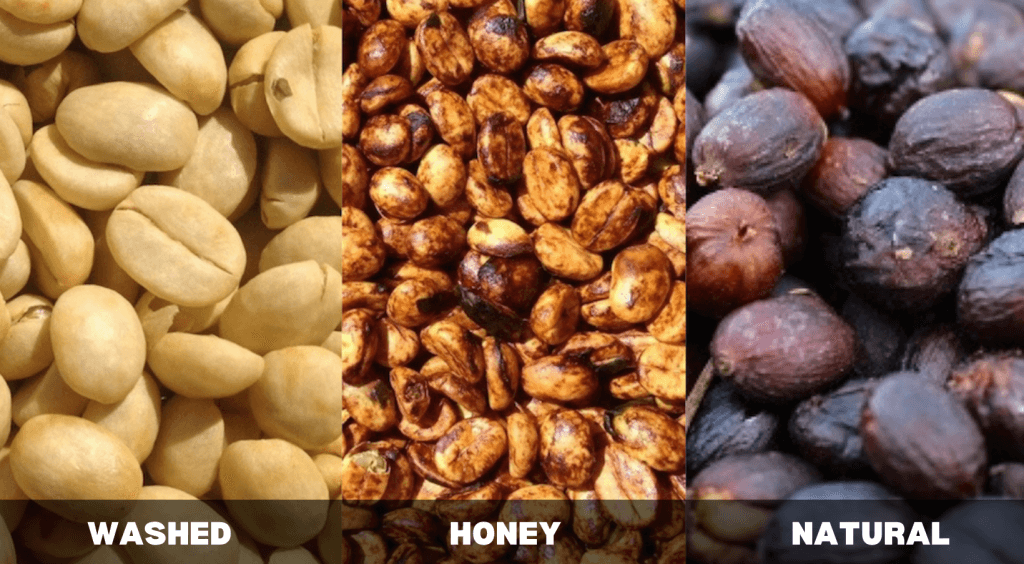Coffee processing is a crucial step that significantly impacts the final flavor profile of your coffee cup. Two of the most notable methods in this process are the washed (or wet) method and the honey (or pulped natural) method. Understanding these methods is essential for coffee enthusiasts, roasters, and baristas alike, as they define the taste, texture, and aroma of the coffee beans. This article will delve into the specifics of washed coffee beans and honey sundried coffee beans, exploring their processing techniques, flavor profiles, and overall impact on the coffee experience.
Washed Coffee Beans
Processing Method
The washed method, also known as the wet method, is one of the most traditional and widely used coffee processing techniques. Here’s how it works:
- Harvesting: Coffee cherries are harvested, typically by hand, to ensure only the ripe cherries are selected.
- Pulping: The outer skin and some of the pulp of the cherries are removed using a depulping machine.
- Fermentation: The beans, still covered in mucilage, are placed in fermentation tanks where they ferment for 12 to 48 hours. This step breaks down the mucilage through enzymatic activity.
- Washing: After fermentation, the beans are washed with clean water to remove the remaining mucilage.
- Drying: The washed beans are then dried, either in the sun on drying patios or in mechanical dryers, until they reach the desired moisture content.
Flavor Profile
Washed coffee beans are prized for their clean and bright flavor profile. Because the fermentation and washing steps remove most of the fruit material from the beans, the intrinsic qualities of the coffee variety, growing conditions, and terroir are highlighted. Here are some typical flavor characteristics of washed coffee beans:
- Clarity: The flavors are more distinct and well-defined.
- Brightness: Washed coffees often have higher acidity, providing a vibrant and lively taste.
- Complexity: These beans can exhibit a wide range of flavors, from floral and fruity notes to nutty and chocolaty undertones.
- Consistency: The washing process allows for more uniformity and predictability in the final product.
Impact on the Coffee Industry
The washed method is favored by many specialty coffee producers and consumers because it produces a consistent and high-quality product. It requires significant amounts of water, which can be a drawback in regions where water scarcity is an issue. However, advances in sustainable practices and water recycling are helping to mitigate these concerns.
Honey Sundried Coffee Beans
Processing Method
The honey process, also known as the pulped natural process, is a hybrid method that combines elements of both washed and natural (dry) processing. It is particularly popular in countries like Costa Rica and El Salvador. Here’s a step-by-step look at the honey process:
- Harvesting: As with the washed method, ripe coffee cherries are handpicked.
- Pulping: The cherries are depulped to remove the outer skin, but unlike the washed process, varying amounts of mucilage are left on the beans.
- Drying: The beans, still covered in mucilage, are laid out to dry on raised beds or patios. The amount of mucilage left on the beans can vary, leading to different categories of honey processing (e.g., black, red, yellow, and white honey), each with varying levels of fruitiness and body.
- Fermentation: Minimal fermentation occurs during the drying phase, influenced by the remaining mucilage and environmental conditions.
Flavor Profile
Honey sundried coffee beans occupy a unique space in the flavor spectrum, offering a balance between the clarity of washed coffees and the fruity richness of natural processed beans. Here are some key flavor characteristics:
- Sweetness: The residual mucilage contributes to a pronounced sweetness in the cup.
- Body: Honey processed coffees often have a fuller body and a syrupy mouthfeel.
- Fruitiness: Depending on the amount of mucilage left, these beans can exhibit varying degrees of fruity flavors, from subtle to intense.
- Acidity: The acidity is generally more moderate compared to washed coffees, providing a smoother taste experience.
Impact on the Coffee Industry
The honey process is valued for its ability to enhance sweetness and body without the need for extensive water usage, making it a more sustainable option in water-scarce regions. It requires careful monitoring during drying to prevent over-fermentation or mold development, which can compromise quality. Producers who master the honey process can create unique and highly desirable coffee profiles that stand out in the market.
Comparative Analysis
Environmental Impact
One of the key differences between the two methods is their environmental impact. The washed process uses a significant amount of water, which can strain resources in areas with limited water availability. Efforts are being made to develop more water-efficient systems and recycling methods to address this issue.
In contrast, the honey process is more water-efficient, making it a more sustainable option. However, it requires precise control and attention to detail during the drying phase to avoid quality issues.
Flavor and Quality
Flavor is the most apparent distinction for consumers. Washed coffees are celebrated for their clean, bright, and complex flavors. They are often preferred in regions where clarity and acidity are prized attributes. Specialty coffee shops frequently feature washed coffees to showcase the purest expression of the coffee’s origin and variety.
Honey processed coffees, with their enhanced sweetness and body, appeal to those who enjoy a richer and more balanced cup. The varying levels of fruitiness and body, depending on the specific honey process used, allow for a diverse range of flavor experiences. These coffees are ideal for espresso-based drinks where a syrupy mouthfeel and sweetness can enhance the overall flavor profile.
Economic Considerations
From an economic perspective, the choice of processing method can affect the marketability and price of the coffee. Washed coffees, given their consistency and clarity, often command higher prices in specialty markets. The predictability of the flavor profile makes them a reliable choice for buyers.
Honey processed coffees, on the other hand, can also fetch premium prices, especially if they exhibit unique and desirable flavor characteristics. The added complexity and sweetness can make them highly sought after by roasters looking to offer something distinctive.
Consumer Preferences
Consumer preferences play a significant role in the popularity of each processing method. In markets where bright and acidic coffees are favored, washed coffees are more likely to be in demand. Conversely, in regions or among consumers who prefer sweeter and fuller-bodied coffees, honey processed beans will be more popular.
Conclusion
Both washed and honey sundried coffee beans offer unique advantages and flavor profiles that cater to different tastes and preferences. The washed method produces clean, bright, and complex coffees that highlight the intrinsic qualities of the beans. This method requires significant water resources but offers consistency and predictability in the final product.
The honey process, with its balanced approach, results in sweet, full-bodied coffees with varying levels of fruitiness. It is more water-efficient but demands meticulous attention during drying to ensure high quality. This method provides a sustainable alternative and allows for a wide range of flavor experiences.
Ultimately, the choice between washed and honey sundried coffee beans depends on a combination of environmental, economic, and personal taste considerations. For coffee enthusiasts, understanding these differences enhances the appreciation of the intricate journey from bean to cup and the diverse flavors that make coffee a universally beloved beverage.








